How Serious Is Undercarriage Damage? [Pretty Serious]
March 19, 2023
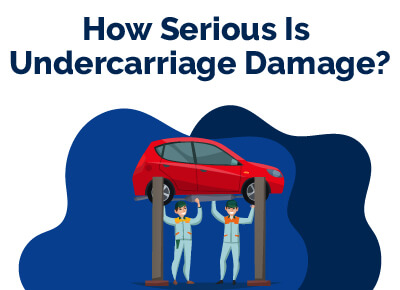

Chris is Head of Content for FindTheBestCarPrice and is based out of Philadelphia, PA. As a seasoned automotive industry analyst and car enthusiast, he ensures the highest level of quality across all our content and curates our picks for the best deals each month.
Chris studied information systems and marketing at Drexel University and writes about a wide range of topics ranging from car buying tips to troubleshooting common mechanical issues.
When he’s not thinking about cars, he likes to stay in with his dog and make an “attempt” to finish a crossword puzzle (he’s not quite at the Saturday/Sunday level…yet). As a former cheesemonger, Chris still has a “sharp” passion for all things cheese, and his fridge is always loaded with it!
Chris also has a passion for things that go fast, and drones are no exception. He spends some of his time writing for Dronesourced.
Whether you’re purchasing a used car or just got in a wreck, you may find yourself wondering just how serious undercarriage damage is.
Long story short, undercarriage damage is pretty serious and should be investigated before you even think about buying or driving a damaged car.
By the end of this post you will learn how serious undercarriage damage can be, as well as how to spot and avoid or minimize any potential issues that may arise from it in order to ensure a safe driving experience.
- Get a fair price for your car no matter the condition (totaled, flooded, scrap, etc.)
- Instant cash offer, good for 7 days
- Free towing and you'll avoid typical junk removal fees
- Sell your vehicle without leaving your home.
Table of Contents
What Is Undercarriage Damage?
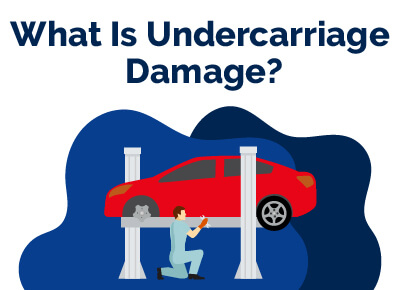 Undercarriage damage refers to any damage to the underside of a vehicle, ranging from minor cosmetic issues to major structural problems that can have safety implications and costly repairs.
Undercarriage damage refers to any damage to the underside of a vehicle, ranging from minor cosmetic issues to major structural problems that can have safety implications and costly repairs.
The undercarriage serves as an important part of the car’s overall structure, so it’s important to make sure there is no damage to the undercarriage following a car accident or when purchasing a used car.
Regular inspections of the undercarriage are a must when buying a used car, as even minor damage can cause major headaches down the line. Checking for suspension and driveshaft damages, plastic guard cracks, holes, and oil pan leaks is key to avoiding any nasty surprises.
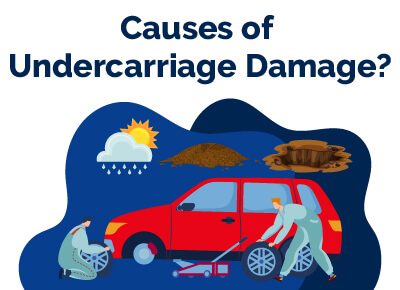
Common Causes Of Undercarriage Damage
Undercarriage damage extends beyond the aftermath of collisions, with several other factors posing risks to your vehicle's lower section.
Exposure to harsh conditions, adventurous off-roading, and insufficient maintenance can all contribute to undercarriage wear and tear.
Potholes
One common hazard is potholes. Especially for vehicles with lowered suspension or smaller tires, navigating over potholes can lead to significant undercarriage damage. The impact can cause cracks, leaks, and even damage the suspension system. It's crucial to drive carefully on pothole-ridden roads and consider the potential for undercarriage protection if your route frequently includes such conditions.
Salt
Road salt, while beneficial for preventing ice buildup, can be a double-edged sword. Its corrosive nature attacks the metal components of the undercarriage, leading to rust and corrosion over time. To combat this, regular applications of a protective sealant and periodic waxing of your vehicle can form a barrier against salt. This is particularly important in colder climates where road salt is a common sight in winter.
Mud
Mud may seem harmless, but it can be a silent destroyer of the undercarriage. The real issue lies in the moisture trapped within the mud, which can lead to rust and corrosion. For those who frequently venture off-road or find themselves driving on muddy paths, ensuring that the undercarriage is thoroughly cleaned after such excursions is key to preventing moisture-related damage.
Worn Shock Absorbers
Shock absorbers play a pivotal role in smoothing out the ride over bumps and dips. However, when they wear out, the vehicle loses its ability to effectively absorb road shocks. This not only makes for an uncomfortable ride but can also result in undercarriage damage from the increased impact with the road surface. Regular checks and timely replacement of shock absorbers are essential to maintain both the comfort and integrity of your vehicle.
Types of Undercarriage Damage
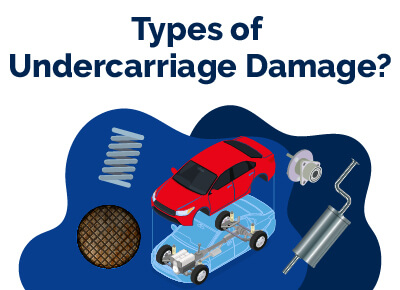 The most common type of undercarriage damage is suspension damage which includes worn shocks and struts as well as broken springs and control arms.
The most common type of undercarriage damage is suspension damage which includes worn shocks and struts as well as broken springs and control arms.
This type of wear will usually show up in visible forms like excessive tire wear on one side or uneven ride height between wheels on opposite sides. If left unchecked, this type of damage can lead to more severe mechanical issues like misalignment and steering problems down the line.
Another common issue is driveshaft damages which are often caused by improper lubrication, leading to rusting joints that become loose or bent out of shape over time. This type of damage is usually due to the torque being applied incorrectly during acceleration/deceleration cycles over long periods (this is what happens when driving through snow.)
Lastly, oil pans are susceptible to undercarriage damage, too. If you notice any leaking fluids coming from your vehicle’s underside, then this could indicate an underlying problem with either its gasket sealer or its pan itself.
How Serious Is Undercarriage Damage?
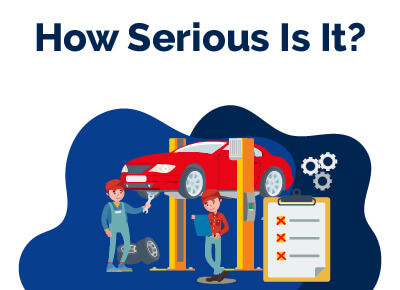 Undercarriage damage is a serious issue for car owners. It can cause major problems with the vehicle’s performance and safety, as well as lead to costly repairs.
Undercarriage damage is a serious issue for car owners. It can cause major problems with the vehicle’s performance and safety, as well as lead to costly repairs.
The undercarriage is essential for safeguarding the car from road hazards and wear and tear, so any damage to this area can have dire results if left unattended.
In addition to costing money for repairs, undercarriage damage also affects a vehicle’s performance and safety negatively.
Damaged suspension components can cause excessive tire wear and alignment issues, which reduce handling ability and increase stopping distance in emergency situations.
Damaged oil pans or driveshafts can leak fluid onto hot engine parts causing smoke or even fire hazards while driving at highway speeds.
It’s important to address any underbody issues as immediately as possible since they can quickly become more serious if left unaddressed.
How to Know If Your Undercarriage Is Damaged?
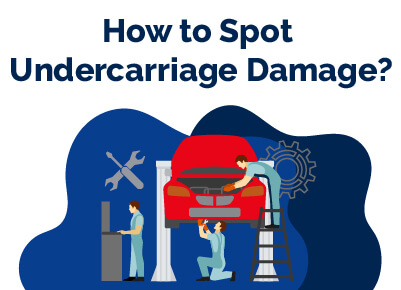 Visual inspection is the first step in identifying potential problems with your vehicle’s undercarriage.
Visual inspection is the first step in identifying potential problems with your vehicle’s undercarriage.
This involves taking a close look at all parts of the underside, including wheel wells, suspension components, and exhaust systems. Look for any dents or scratches that could indicate damage from rocks or other objects on the road.
Pay special attention to areas where rust may have formed due to moisture buildup over time. If any issues are identified, have an expert evaluate them promptly.
Professional inspections are also useful for detecting hidden issues, such as corrosion or worn-out parts that may not be visible during a visual inspection. During this type of checkup, mechanics use specialized tools and equipment such as borescopes and ultrasound machines to detect any underlying problems with the car’s undercarriage that might go unnoticed by an untrained eye.
If you're feeling bold and want to take a crack at inspecting your vehicle's undercarriage yourself, use these tips to stay safe and be as thorough as possible:
- Illuminate the area with plenty of light so that nothing goes unseen
- Wear protective gear such as gloves and goggles
- When delving into tight spaces, use a flashlight
- Lift up one side of the car at a time for an optimal inspection
- Snap pictures along the way to ensure nothing is overlooked
Inspecting your vehicle’s undercarriage regularly is key when it comes to spotting potential damage before it becomes serious enough to cause major repair bills down the line.
How to Avoid or Minimize Undercarriage Damage?
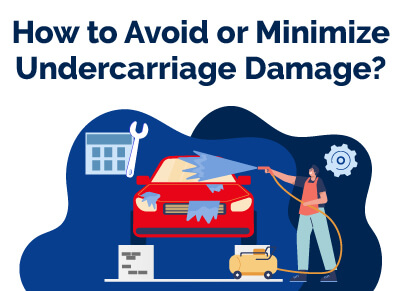 Regular maintenance and cleaning are essential for avoiding or minimizing undercarriage damage.
Regular maintenance and cleaning are essential for avoiding or minimizing undercarriage damage.
Do your best to keep the vehicle free from dirt, mud, and other foreign matter in order to avoid corrosion on its underside.
Regularly checking for any loose parts or rust can also help identify potential problems before they become more serious. Changing out fluids such as oil and coolant regularly can help protect against excessive wear and tear that could lead to undercarriage damage.
Driving habits can also play a role in preventing undercarriage damage. Driving too fast over bumps or potholes can cause shock to be transferred through the frame, which may cause components like exhaust systems to loosen up or break off completely.
Taking extra care when driving over gravel roads is especially important since this type of terrain tends to be much rougher than paved roads and can easily chip away at protective coatings on metal surfaces if not driven over properly.
Best Car Deals by Category
Frequently Asked Questions
Is damage to the undercarriage serious?
Damage to the undercarriage of a car can be serious and should be taken care of as soon as possible.
Is it safe to drive with a broken undercarriage?
It is not safe to drive with a broken undercarriage since it’s difficult to tell what all is wrong with the vehicle.
What does undercarriage damage on a car mean?
Undercarriage damage on a car refers to any type of damage that has occurred to the underside of the vehicle.
What does undercarriage damage mean on Copart?
Damage to the undercarriage of a vehicle on Copart may include harm done to its frame, suspension elements, exhaust system, and other components.
Posted in Car Buying Tips |





